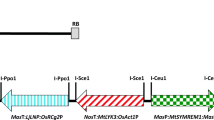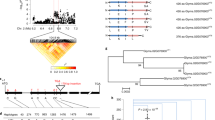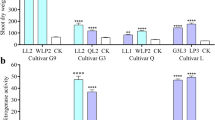Abstract
Legumes have evolved a symbiotic relationship with rhizobial bacteria and their roots form unique nitrogen-fixing organs called nodules. Studies have shown that abiotic and biotic stresses alter the profile of gene expression and transcript mobility in plants. However, little is known about the systemic transport of RNA between roots and shoots in response to rhizobial infection on a genome-wide scale during the formation of legume-rhizobia symbiosis. In our study, we found that two soybean (Glycine max) cultivars, Peking and Williams, show a high frequency of single nucleotide polymorphisms; this allowed us to characterize the origin and mobility of transcripts in hetero-grafts of these two cultivars. We identified 4,552 genes that produce mobile RNAs in soybean, and found that rhizobial infection triggers mass transport of mRNAs between shoots and roots at the early stage of nodulation. The majority of these mRNAs are of relatively low abundance and their transport occurs in a selective manner in soybean plants. Notably, the mRNAs that moved from shoots to roots at the early stage of nodulation were enriched in many nodule-related responsive processes. Moreover, the transcripts of many known symbiosis-related genes that are induced by rhizobial infection can move between shoots and roots. Our findings provide a deeper understanding of endogenous RNA transport in legume-rhizobia symbiotic processes.
Similar content being viewed by others
References
Abdel-Latif, A., and Osman, G. (2017). Comparison of three genomic DNA extraction methods to obtain high DNA quality from maize. Plant Methods 13, 1.
Aoki, K., Suzui, N., Fujimaki, S., Dohmae, N., Yonekura-Sakakibara, K., Fujiwara, T., Hayashi, H., Yamaya, T., and Sakakibara, H. (2005). Destination-selective long-distance movement of phloem proteins. Plant Cell 17, 1801–1814.
Baier, M.C., Barsch, A., Küster, H., and Hohnjec, N. (2007). Antisense repression of the Medicago truncatula nodule-enhanced sucrose synthase leads to a handicapped nitrogen fixation mirrored by specific alterations in the symbiotic transcriptome and metabolome. Plant Physiol 145, 1600–1618.
Banerjee, A.K., Chatterjee, M., Yu, Y., Suh, S.G., Miller, W.A., and Hannapel, D.J. (2006). Dynamics of a mobile RNA of potato involved in a long-distance signaling pathway. Plant Cell 18, 3443–3457.
Bishop, P.E., Guevara, J.G., Engelke, J.A., and Evans, H.J. (1976). Relation between glutamine synthetase and nitrogenase activities in the symbiotic association between Rhizobium japonicum and Glycine max. Plant Physiol 57, 542–546.
Boivin, S., Fonouni-Farde, C., and Frugier, F. (2016). How auxin and cytokinin phytohormones modulate root microbe interactions. Front Plant Sci 7, 1240.
Breakspear, A., Liu, C., Roy, S., Stacey, N., Rogers, C., Trick, M., Morieri, G., Mysore, K.S., Wen, J., Oldroyd, G.E.D., et al. (2014). The root hair “infectome” of Medicago truncatula uncovers changes in cell cycle genes and reveals a requirement for auxin signaling in rhizobial infection. Plant Cell 26, 4680–4701.
Calderwood, A., Kopriva, S., and Morris, R.J. (2016). Transcript abundance explains mRNA mobility data in Arabidopsis thaliana. Plant Cell 28, 610–615.
Camp, R.O., Streng, A., De Mita, S., Cao, Q., Polone, E., Liu, W., Ammiraju, J.S.S., Kudrna, D., Wing, R., Untergasser, A., et al. (2011). LysM-type mycorrhizal receptor recruited for rhizobium symbiosis in nonlegume Parasponia. Science 331, 909–912.
Cerri, M.R., Wang, Q., Stolz, P., Folgmann, J., Frances, L., Katzer, K., Li, X., Heckmann, A.B., Wang, T.L., Downie, J.A., et al. (2017). The ERN1 transcription factor gene is a target of the CCaMK/CYCLOPS complex and controls rhizobial infection in Lotus japonicus. New Phytol 215, 323–337.
Charpentier, M., Bredemeier, R., Wanner, G., Takeda, N., Schleiff, E., and Parniske, M. (2008). Lotus japonicus CASTOR and POLLUX are ion channels essential for perinuclear calcium spiking in legume root endosymbiosis. Plant Cell 20, 3467–3479.
Combier, J.P., Frugier, F., de Billy, F., Boualem, A., El-Yahyaoui, F., Moreau, S., Vernié, T., Ott, T., Gamas, P., Crespi, M., et al. (2006). MtHAP2-1 is a key transcriptional regulator of symbiotic nodule development regulated by microRNA169 in Medicago truncatula. Genes Dev 20, 3084–3088.
Cook, D., Dreyer, D., Bonnet, D., Howell, M., Nony, E., and VandenBosch, K. (1995). Transient induction of a peroxidase gene in Medicago truncatula precedes infection by Rhizobium meliloti. Plant Cell 7, 43–55.
Dalla Via, V., Traubenik, S., Rivero, C., Aguilar, O.M., Zanetti, M.E., and Blanco, F.A. (2017). The monomeric GTPase RabA2 is required for progression and maintenance of membrane integrity of infection threads during root nodule symbiosis. Plant Mol Biol 93, 549–562.
Davidson, A.L., and Newcomb, W. (2001). Organization of microtubules in develo** pea root nodule cells. Can J Bot 79, 777–786.
de Zélicourt, A., Diet, A., Marion, J., Laffont, C., Ariel, F., Moison, M., Zahaf, O., Crespi, M., Gruber, V., and Frugier, F. (2012). Dual involvement of a Medicago truncatula NAC transcription factor in root abiotic stress response and symbiotic nodule senescence. Plant J 70, 220–230.
Ding, Y., Kalo, P., Yendrek, C., Sun, J., Liang, Y., Marsh, J.F., Harris, J.M., and Oldroyd, G.E.D. (2008). Abscisic acid coordinates nod factor and cytokinin signaling during the regulation of nodulation in Medicago truncatula. Plant Cell 20, 2681–2695.
Estrada-Navarrete, G., Cruz-Mireles, N., Lascano, R., Alvarado-Affantranger, X., Hernández-Barrera, A., Barraza, A., Olivares, J.E., Arthikala, M.K., Cárdenas, L., Quinto, C., et al. (2016). An autophagyrelated kinase is essential for the symbiotic relationship between Phaseolus vulgaris and both rhizobia and arbuscular mycorrhizal fungi. Plant Cell 28, 2326–2341.
Ferguson, B.J., and Mathesius, U. (2014). Phytohormone regulation of legume-rhizobia interactions. J Chem Ecol 40, 770–790.
Floss, D.S., Gomez, S.K., Park, H.J., MacLean, A.M., Müller, L.M., Bhattarai, K.K., Lévesque-Tremblay, V., Maldonado-Mendoza, I.E., and Harrison, M.J. (2017). A transcriptional program for arbuscule degeneration during AM symbiosis is regulated by MYB1. Curr Biol 27, 1206–1212.
Foo, E., Ferguson, B.J., and Reid, J.B. (2014). Common and divergent roles of plant hormones in nodulation and arbuscular mycorrhizal symbioses. Plant Signal Behav 9, e29593.
Gaude, N., Tippmann, H., Flemetakis, E., Katinakis, P., Udvardi, M., and Dörmann, P. (2004). The galactolipid digalactosyldiacylglycerol accumulates in the peribacteroid membrane of nitrogen-fixing nodules of soybean and Lotus. J Biol Chem 279, 34624–34630.
Geurts, R., and Bisseling, T. (2002). Rhizobium nod factor perception and signalling. Plant Cell 14, S239–S249.
Gonzalez-Rizzo, S., Crespi, M., and Frugier, F. (2006). The Medicago truncatula CRE1 cytokinin receptor regulates lateral root development and early symbiotic interaction with Sinorhizobium meliloti. Plant Cell 18, 2680–2693.
Ham, B.K., Brandom, J.L., Xoconostle-Cázares, B., Ringgold, V., Lough, T.J., and Lucas, W.J. (2009). A polypyrimidine tract binding protein, pumpkin RBP50, forms the basis of a phloem-mobile ribonucleoprotein complex. Plant Cell 21, 197–215.
Ham, B.K., and Lucas, W.J. (2017). Phloem-mobile RNAs as systemic signaling agents. Annu Rev Plant Biol 68, 173–195.
Hannapel, D.J. (2010). A model system of development regulated by the long-distance transport of mRNA. J Integr Plant Biol 52, 40–52.
Hardham, A.R. (2013). Microtubules and biotic interactions. Plant J 75, 278–289.
Hayashi, T., Shimoda, Y., Sato, S., Tabata, S., Imaizumi-Anraku, H., and Hayashi, M. (2014). Rhizobial infection does not require cortical expression of upstream common symbiosis genes responsible for the induction of Ca2+ spiking. Plant J 77, 146–159.
Haywood, V., Yu, T.S., Huang, N.C., and Lucas, W.J. (2005). Phloem long-distance trafficking of GIBBERELLIC ACID-INSENSITIVE RNA regulates leaf development. Plant J 42, 49–68.
Heard, J., Caspi, M., and Dunn, K. (1997). Evolutionary diversity of symbiotically induced nodule MADS box genes: Characterization of nmhC5, a member of a novel subfamily. Mol Plant Microbe Interact 10, 665–676.
Huang, N.C., and Yu, T.S. (2009). The sequences of Arabidopsis GAINSENSITIVE RNA constitute the motifs that are necessary and sufficient for RNA long-distance trafficking. Plant J 59, 921–929.
Imin, N., Mohd-Radzman, N.A., Ogilvie, H.A., and Djordjevic, M.A. (2013). The peptide-encoding CEP1 gene modulates lateral root and nodule numbers in Medicago truncatula. J Exp Bot 64, 5395–5409.
Kehr, J., and Buhtz, A. (2008). Long distance transport and movement of RNA through the phloem. J Exp Bot 59, 85–92.
Kehr, J., and Kragler, F. (2018). Long distance RNA movement. New Phytol 218, 29–40.
Kereszt, A., Li, D., Indrasumunar, A., Nguyen, C.D.T., Nontachaiyapoom, S., Kinkema, M., and Gresshoff, P.M. (2007). Agrobacterium rhizogenes-mediated transformation of soybean to study root biology. Nat Protoc 2, 948–952.
Kim, G., LeBlanc, M.L., Wafula, E.K., dePamphilis, C.W., and Westwood, J.H. (2014). Genomic-scale exchange of mRNA between a parasitic plant and its hosts. Science 345, 808–811.
Kitaeva, A.B., Demchenko, K.N., Tikhonovich, I.A., Timmers, A.C.J., and Tsyganov, V.E. (2016). Comparative analysis of the tubulin cytoskeleton organization in nodules of Medicago truncatula and Pisum sativum: Bacterial release and bacteroid positioning correlate with characteristic microtubule rearrangements. New Phytol 210, 168–183.
Laporte, P., Lepage, A., Fournier, J., Catrice, O., Moreau, S., Jardinaud, M. F., Mun, J.H., Larrainzar, E., Cook, D.R., Gamas, P., et al. (2014). The CCAAT box-binding transcription factor NF-YA1 controls rhizobial infection. J Exp Bot 65, 481–494.
Lauridsen, P., Franssen, H., Stougaard, J., Bisseling, T., and Marcker, K.A. (1993). Conserved regulation of the soybean early nodulin ENOD2 gene promoter in determinate and indeterminate transgenic root nodules. Plant J 3, 483–492.
Liang, P., Stratil, T.F., Popp, C., Marín, M., Folgmann, J., Mysore, K.S., Wen, J., and Ott, T. (2018). Symbiotic root infections in Medicago truncatula require remorin-mediated receptor stabilization in membrane nanodomains. Proc Natl Acad Sci USA 115, 5289–5294.
Limpens, E., Franken, C., Smit, P., Willemse, J., Bisseling, T., and Geurts, R. (2003). LysM domain receptor kinases regulating rhizobial nod factor-induced infection. Science 302, 630–633.
Lucas, W.J., Groover, A., Lichtenberger, R., Furuta, K., Yadav, S.R., Helariutta, Y., He, X.Q., Fukuda, H., Kang, J., Brady, S.M., et al. (2013). The plant vascular system: Evolution, development and functions. J Integr Plant Biol 55, 294–388.
Lucas, W.J., Yoo, B.C., and Kragler, F. (2001). RNA as a long-distance information macromolecule in plants. Nat Rev Mol Cell Biol 2, 849–857.
Mbengue, M., Camut, S., de Carvalho Niebel, F., Deslandes, L., Froidure, S., Klaus-Heisen, D., Moreau, S., Rivas, S., Timmers, T., Hervé, C., et al. (2010). The Medicago truncatula E3 ubiquitin ligase PUB1 interacts with the LYK3 symbiotic receptor and negatively regulates infection and nodulation. Plant Cell 22, 3474–3488.
Soyano, T., Kouchi, H., Hirota, A., and Hayashi, M. (2013). NODULE INCEPTION directly targets NF-Y subunit genes to regulate essential processes of root nodule development in Lotus japonicus. PLoS Genet 9, e1003352.
Minami, E., Kouchi, H., Carlson, R.W., Cohn, J.R., Kolli, V.K., Day, R.B., Ogawa, T., and Stacey, G. (1996). Cooperative action of lipo-chitin nodulation signals on the induction of the early nodulin, ENOD2, in soybean roots. Mol Plant Microbe Interact 9, 574–583.
Miri, M., Janakirama, P., Held, M., Ross, L., and Szczyglowski, K. (s2016). Into the root: How cytokinin controls rhizobial infection. Trends Plant Sci 21, 178–186.
Morell, M., and Copeland, L. (1985). Sucrose synthase of soybean nodules. Plant Physiol 78, 149–154.
Nanjareddy, K., Blanco, L., Arthikala, M.K., Alvarado-Affantranger, X., Quinto, C., Sánchez, F., and Lara, M. (2016). A legume TOR protein kinase regulates Rhizobium symbiosis and is essential for infection and nodule development. Plant Physiol 172, 2002–2020.
Niebel, F.d.C., Lescure, N., Cullimore, J.V., and Gamas, P. (1998). The Medicago truncatula MtAnn1 gene encoding an annexin is induced by nod factors and during the symbiotic interaction with Rhizobium meliloti. Mol Plant Microbe Interact 11, 504–513.
Notaguchi, M., Higashiyama, T., and Suzuki, T. (2015). Identification of mRNAs that move over long distances using an RNA-Seq analysis of Arabidopsis/Nicotiana benthamiana heterografts. Plant Cell Physiol 56, 311–321.
Oldroyd, G.E.D. (2013). Speak, friend, and enter: Signalling systems that promote beneficial symbiotic associations in plants. Nat Rev Microbiol 11, 252–263.
Oldroyd, G.E.D., and Downie, J.A. (2004). Calcium, kinases and nodulation signalling in legumes. Nat Rev Mol Cell Biol 5, 566–576.
Paultre, D.S.G., Gustin, M.P., Molnar, A., and Oparka, K.J. (2016). Lost in transit: Long-distance trafficking and phloem unloading of protein signals in Arabidopsis homografts. Plant Cell 28, 2016–2025.
Peng, H.M., Dreyer, D.A., VandenBosch, K.A., and Cook, D. (1996). Gene structure and differential regulation of the Rhizobium-induced peroxidase gene rip1. Plant Physiol 112, 1437–1446.
Qin, L., Wang, M., Chen, L., Liang, X., Wu, Z., Lin, Z., Zuo, J., Feng, X., Zhao, J., Liao, H., et al. (2015). Soybean Fe-S cluster biosynthesis regulated by external iron or phosphate fluctuation. Plant Cell Rep 34, 411–424.
Ramu, S.K., Peng, H.M., and Cook, D.R. (2002). Nod factor induction of reactive oxygen species production is correlated with expression of the early nodulin gene rip1 in Medicago truncatula. Mol Plant Microbe Interact 15, 522–528.
Remigi, P., Zhu, J., Young, J.P.W., and Masson-Boivin, C. (2016). Symbiosis within symbiosis: Evolving nitrogen-fixing legume symbionts. Trends Microbiol 24, 63–75.
Routray, P., Miller, J.B., Du, L., Oldroyd, G., and Poovaiah, B.W. (2013). Phosphorylation of S344 in the calmodulin-binding domain negatively affects CCaMK function during bacterial and fungal symbioses. Plant J 76, 287–296.
Sasaki, T., Suzaki, T., Soyano, T., Kojima, M., Sakakibara, H., and Kawaguchi, M. (2014). Shoot-derived cytokinins systemically regulate root nodulation. Nat Commun 5, 4983.
Shen, Y., Liu, J., Geng, H., Zhang, J., Liu, Y., Zhang, H., **ng, S., Du, J., Ma, S., and Tian, Z. (2018). De novo assembly of a Chinese soybean genome. Sci China Life Sci 61, 871–884.
Shen, Y., Du, H., Liu, Y., Ni, L., Wang, Z., Liang, C., and Tian, Z. (2019). Update soybean Zhonghuang 13 genome to a golden reference. Sci China Life Sci 62, 1257–1260.
Shimoda, Y., Han, L., Yamazaki, T., Suzuki, R., Hayashi, M., and Imaizumi-Anraku, H. (2012). Rhizobial and fungal symbioses show different requirements for calmodulin binding to calcium calmodulin-dependent protein kinase in Lotus japonicus. Plant Cell 24, 304–321.
Sinharoy, S., Torres-Jerez, I., Bandyopadhyay, K., Kereszt, A., Pislariu, C. I., Nakashima, J., Benedito, V.A., Kondorosi, E., and Udvardi, M.K. (2013). The C2H2 transcription factor regulator of symbiosome differentiation represses transcription of the secretory pathway gene VAMP721a and promotes symbiosome development in Medicago truncatula. Plant Cell 25, 3584–3601.
Suzaki, T., Yano, K., Ito, M., Umehara, Y., Suganuma, N., and Kawaguchi, M. (2012). Positive and negative regulation of cortical cell division during root nodule development in Lotus japonicus is accompanied by auxin response. Development 139, 3997–4006.
Takeda, N., Maekawa, T., and Hayashi, M. (2012). Nuclear-localized and deregulated calcium-and calmodulin-dependent protein kinase activates rhizobial and mycorrhizal responses in Lotus japonicus. Plant Cell 24, 810–822.
Thieme, C.J., Rojas-Triana, M., Stecyk, E., Schudoma, C., Zhang, W., Yang, L., Miñambres, M., Walther, D., Schulze, W.X., Paz-Ares, J., et al. (2015). Endogenous Arabidopsis messenger RNAs transported to distant tissues. Nat Plants 1, 15025.
Vassileva, V.N., Kouchi, H., and Ridge, R.W. (2005). Microtubule dynamics in living root hairs: Transient slowing by lipochitin oligosaccharide nodulation signals. Plant Cell 17, 1777–1787.
Wang, Y., Li, P., Cao, X., Wang, X., Zhang, A., and Li, X. (2009). Identification and expression analysis of miRNAs from nitrogen-fixing soybean nodules. Biochem Biophys Res Commun 378, 799–803.
Wang, Z., Li, P., Yang, Y., Chi, Y., Fan, B., and Chen, Z. (2016). Expression and functional analysis of a novel group of legume-specific WRKY and Exo70 protein variants from soybean. Sci Rep 6, 32090.
Yan, Z., Hossain, M.S., Valdés-López, O., Hoang, N.T., Zhai, J., Wang, J., Libault, M., Brechenmacher, L., Findley, S., Joshi, T., et al. (2016). Identification and functional characterization of soybean root hair microRNAs expressed in response to Bradyrhizobium japonicum infection. Plant Biotechnol J 14, 332–341.
Yang, Y., Mao, L., Jittayasothorn, Y., Kang, Y., Jiao, C., Fei, Z., and Zhong, G.Y. (2015). Messenger RNA exchange between scions and rootstocks in grafted grapevines. BMC Plant Biol 15, 251.
Yano, K., Aoki, S., Liu, M., Umehara, Y., Suganuma, N., Iwasaki, W., Sato, S., Soyano, T., Kouchi, H., and Kawaguchi, M. (2017). Function and evolution of a Lotus japonicus AP2/ERF family transcription factor that is required for development of infection threads. DNA Res 24, 193–203.
Yin, J., Guan, X., Zhang, H., Wang, L., Li, H., Zhang, Q., Chen, T., Xu, Z., Hong, Z., Cao, Y., et al. (2019). An MAP kinase interacts with LHK1 and regulates nodule organogenesis in Lotus japonicus. Sci China Life Sci 62, 1203–1217.
Zhang, S., Sun, L., and Kragler, F. (2009). The phloem-delivered RNA pool contains small noncoding RNAs and interferes with translation. Plant Physiol 150, 378–387.
Zhang, W., Thieme, C.J., Kollwig, G., Apelt, F., Yang, L., Winter, N., Andresen, N., Walther, D., and Kragler, F. (2016). tRNA-related sequences trigger systemic mRNA transport in plants. Plant Cell 28, 1237–1249.
Zhang, Z., Zheng, Y., Ham, B.K., Chen, J., Yoshida, A., Kochian, L.V., Fei, Z., and Lucas, W.J. (2016). Vascular-mediated signalling involved in early phosphate stress response in plants. Nat Plants 2, 16033.
Zhong, S., Joung, J.G., Zheng, Y., Chen, Y., Liu, B., Shao, Y., **ang, J.Z., Fei, Z., and Giovannoni, J.J. (2011). High-throughput illumina strandspecific RNA sequencing library preparation. Cold Spring Harb Protoc 2011, 940–949.
Acknowledgements
This work was supported by the Key Research Program from the Chinese Academy of Sciences (ZDRW-ZS-2019-2) and the “Strategic Priority Research Program” of the Chinese Academy of Sciences (XDA08000000). We are grateful to Patrick Elia and Esther Peregrine (Agricultural Research Service, United States Department of Agriculture) for providing the B. diazoefficiens strain USDA 110 and the Soybean seeds (Glycine max cv. Williams and Glycine max cv. Peking). We thank Dr. Peter M. Gresshoff (Australian Research Council Centre of Excellence for Integrative Legume Research, The University of Queensland) for providing the Agrobacterium rhizogenes strain K599. We thank Dr. Shouyi Chen (Institute of Genetics and Developmental Biology, Chinese Academy of Sciences) for technical support of soybean hairy root transformation.
Author information
Authors and Affiliations
Corresponding authors
Electronic supplementary material
Rights and permissions
About this article
Cite this article
Zhang, C., Qi, M., Zhang, X. et al. Rhizobial infection triggers systemic transport of endogenous RNAs between shoots and roots in soybean. Sci. China Life Sci. 63, 1213–1226 (2020). https://doi.org/10.1007/s11427-019-1608-7
Received:
Accepted:
Published:
Issue Date:
DOI: https://doi.org/10.1007/s11427-019-1608-7




